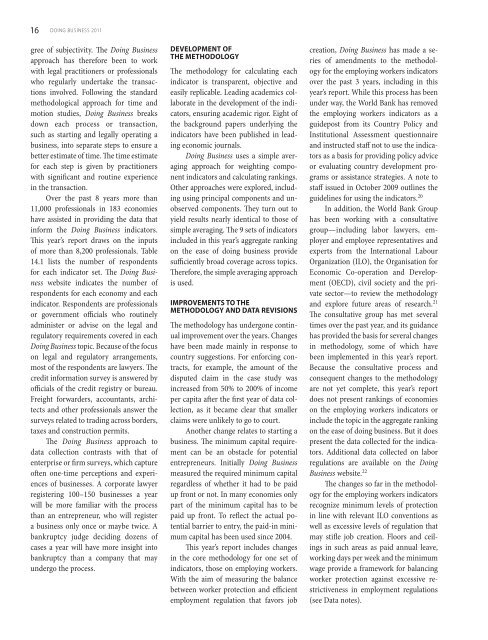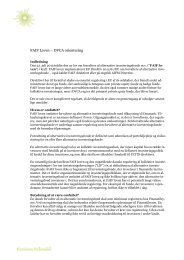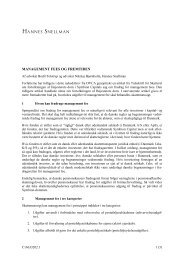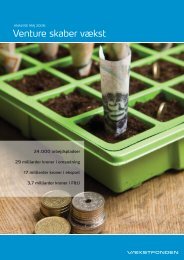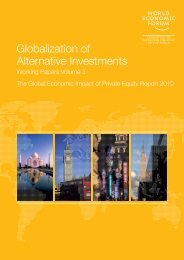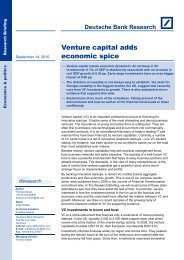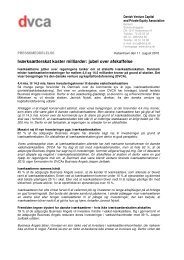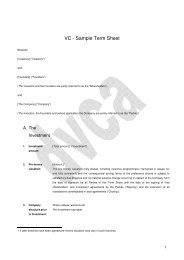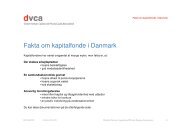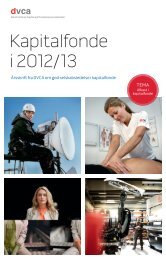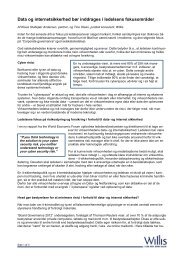A copublication of The World Bank and the - DVCA
A copublication of The World Bank and the - DVCA
A copublication of The World Bank and the - DVCA
You also want an ePaper? Increase the reach of your titles
YUMPU automatically turns print PDFs into web optimized ePapers that Google loves.
16 DOING BUSINESS 2011<br />
gree <strong>of</strong> subjectivity. <strong>The</strong> Doing Business<br />
approach has <strong>the</strong>refore been to work<br />
with legal practitioners or pr<strong>of</strong>essionals<br />
who regularly undertake <strong>the</strong> transactions<br />
involved. Following <strong>the</strong> st<strong>and</strong>ard<br />
methodological approach for time <strong>and</strong><br />
motion studies, Doing Business breaks<br />
down each process or transaction,<br />
such as starting <strong>and</strong> legally operating a<br />
business, into separate steps to ensure a<br />
better estimate <strong>of</strong> time. <strong>The</strong> time estimate<br />
for each step is given by practitioners<br />
with significant <strong>and</strong> routine experience<br />
in <strong>the</strong> transaction.<br />
Over <strong>the</strong> past 8 years more than<br />
11,000 pr<strong>of</strong>essionals in 183 economies<br />
have assisted in providing <strong>the</strong> data that<br />
inform <strong>the</strong> Doing Business indicators.<br />
This year’s report draws on <strong>the</strong> inputs<br />
<strong>of</strong> more than 8,200 pr<strong>of</strong>essionals. Table<br />
14.1 lists <strong>the</strong> number <strong>of</strong> respondents<br />
for each indicator set. <strong>The</strong> Doing Business<br />
website indicates <strong>the</strong> number <strong>of</strong><br />
respondents for each economy <strong>and</strong> each<br />
indicator. Respondents are pr<strong>of</strong>essionals<br />
or government <strong>of</strong>ficials who routinely<br />
administer or advise on <strong>the</strong> legal <strong>and</strong><br />
regulatory requirements covered in each<br />
Doing Business topic. Because <strong>of</strong> <strong>the</strong> focus<br />
on legal <strong>and</strong> regulatory arrangements,<br />
most <strong>of</strong> <strong>the</strong> respondents are lawyers. <strong>The</strong><br />
credit information survey is answered by<br />
<strong>of</strong>ficials <strong>of</strong> <strong>the</strong> credit registry or bureau.<br />
Freight forwarders, accountants, architects<br />
<strong>and</strong> o<strong>the</strong>r pr<strong>of</strong>essionals answer <strong>the</strong><br />
surveys related to trading across borders,<br />
taxes <strong>and</strong> construction permits.<br />
<strong>The</strong> Doing Business approach to<br />
data collection contrasts with that <strong>of</strong><br />
enterprise or firm surveys, which capture<br />
<strong>of</strong>ten one-time perceptions <strong>and</strong> experiences<br />
<strong>of</strong> businesses. A corporate lawyer<br />
registering 100–150 businesses a year<br />
will be more familiar with <strong>the</strong> process<br />
than an entrepreneur, who will register<br />
a business only once or maybe twice. A<br />
bankruptcy judge deciding dozens <strong>of</strong><br />
cases a year will have more insight into<br />
bankruptcy than a company that may<br />
undergo <strong>the</strong> process.<br />
DEVELOPMENT OF<br />
THE METHODOLOGY<br />
<strong>The</strong> methodology for calculating each<br />
indicator is transparent, objective <strong>and</strong><br />
easily replicable. Leading academics collaborate<br />
in <strong>the</strong> development <strong>of</strong> <strong>the</strong> indicators,<br />
ensuring academic rigor. Eight <strong>of</strong><br />
<strong>the</strong> background papers underlying <strong>the</strong><br />
indicators have been published in leading<br />
economic journals.<br />
Doing Business uses a simple averaging<br />
approach for weighting component<br />
indicators <strong>and</strong> calculating rankings.<br />
O<strong>the</strong>r approaches were explored, including<br />
using principal components <strong>and</strong> unobserved<br />
components. <strong>The</strong>y turn out to<br />
yield results nearly identical to those <strong>of</strong><br />
simple averaging. <strong>The</strong> 9 sets <strong>of</strong> indicators<br />
included in this year’s aggregate ranking<br />
on <strong>the</strong> ease <strong>of</strong> doing business provide<br />
sufficiently broad coverage across topics.<br />
<strong>The</strong>refore, <strong>the</strong> simple averaging approach<br />
is used.<br />
IMPROVEMENTS TO THE<br />
METHODOLOGY AND DATA REVISIONS<br />
<strong>The</strong> methodology has undergone continual<br />
improvement over <strong>the</strong> years. Changes<br />
have been made mainly in response to<br />
country suggestions. For enforcing contracts,<br />
for example, <strong>the</strong> amount <strong>of</strong> <strong>the</strong><br />
disputed claim in <strong>the</strong> case study was<br />
increased from 50% to 200% <strong>of</strong> income<br />
per capita after <strong>the</strong> first year <strong>of</strong> data collection,<br />
as it became clear that smaller<br />
claims were unlikely to go to court.<br />
Ano<strong>the</strong>r change relates to starting a<br />
business. <strong>The</strong> minimum capital requirement<br />
can be an obstacle for potential<br />
entrepreneurs. Initially Doing Business<br />
measured <strong>the</strong> required minimum capital<br />
regardless <strong>of</strong> whe<strong>the</strong>r it had to be paid<br />
up front or not. In many economies only<br />
part <strong>of</strong> <strong>the</strong> minimum capital has to be<br />
paid up front. To reflect <strong>the</strong> actual potential<br />
barrier to entry, <strong>the</strong> paid-in minimum<br />
capital has been used since 2004.<br />
This year’s report includes changes<br />
in <strong>the</strong> core methodology for one set <strong>of</strong><br />
indicators, those on employing workers.<br />
With <strong>the</strong> aim <strong>of</strong> measuring <strong>the</strong> balance<br />
between worker protection <strong>and</strong> efficient<br />
employment regulation that favors job<br />
creation, Doing Business has made a series<br />
<strong>of</strong> amendments to <strong>the</strong> methodology<br />
for <strong>the</strong> employing workers indicators<br />
over <strong>the</strong> past 3 years, including in this<br />
year’s report. While this process has been<br />
under way, <strong>the</strong> <strong>World</strong> <strong>Bank</strong> has removed<br />
<strong>the</strong> employing workers indicators as a<br />
guidepost from its Country Policy <strong>and</strong><br />
Institutional Assessment questionnaire<br />
<strong>and</strong> instructed staff not to use <strong>the</strong> indicators<br />
as a basis for providing policy advice<br />
or evaluating country development programs<br />
or assistance strategies. A note to<br />
staff issued in October 2009 outlines <strong>the</strong><br />
guidelines for using <strong>the</strong> indicators. 20<br />
In addition, <strong>the</strong> <strong>World</strong> <strong>Bank</strong> Group<br />
has been working with a consultative<br />
group—including labor lawyers, employer<br />
<strong>and</strong> employee representatives <strong>and</strong><br />
experts from <strong>the</strong> International Labour<br />
Organization (ILO), <strong>the</strong> Organisation for<br />
Economic Co-operation <strong>and</strong> Development<br />
(OECD), civil society <strong>and</strong> <strong>the</strong> private<br />
sector—to review <strong>the</strong> methodology<br />
<strong>and</strong> explore future areas <strong>of</strong> research. 21<br />
<strong>The</strong> consultative group has met several<br />
times over <strong>the</strong> past year, <strong>and</strong> its guidance<br />
has provided <strong>the</strong> basis for several changes<br />
in methodology, some <strong>of</strong> which have<br />
been implemented in this year’s report.<br />
Because <strong>the</strong> consultative process <strong>and</strong><br />
consequent changes to <strong>the</strong> methodology<br />
are not yet complete, this year’s report<br />
does not present rankings <strong>of</strong> economies<br />
on <strong>the</strong> employing workers indicators or<br />
include <strong>the</strong> topic in <strong>the</strong> aggregate ranking<br />
on <strong>the</strong> ease <strong>of</strong> doing business. But it does<br />
present <strong>the</strong> data collected for <strong>the</strong> indicators.<br />
Additional data collected on labor<br />
regulations are available on <strong>the</strong> Doing<br />
Business website. 22<br />
<strong>The</strong> changes so far in <strong>the</strong> methodology<br />
for <strong>the</strong> employing workers indicators<br />
recognize minimum levels <strong>of</strong> protection<br />
in line with relevant ILO conventions as<br />
well as excessive levels <strong>of</strong> regulation that<br />
may stifle job creation. Floors <strong>and</strong> ceilings<br />
in such areas as paid annual leave,<br />
working days per week <strong>and</strong> <strong>the</strong> minimum<br />
wage provide a framework for balancing<br />
worker protection against excessive restrictiveness<br />
in employment regulations<br />
(see Data notes).


